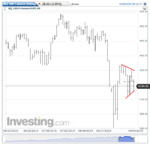dbp, can you advise how to select an appropriate instrument? Should it be a company or sector I am familiar with or something that has suitable volatility/volume? I can appreciate the need to select and record observations in a journal of a single instrument, but how does one choose an instrument that will offer good trading opportunities?
Thanks
I began trading the NQ in '98 because I wanted to trade something I understood. Since then I've come to appreciate mean reversion and the ease of trading something that is mean-reverting. I've also come to appreciate an awareness of the group or groups that one is trading with, or against if one wants to look at it that way. The obsession with the ES has never made sense to me as it involves trading with/against the best traders in the world. I'd much rather trade with/against the worst.
Dividing instruments into categories may be of help: stocks and stock indices, commodities, currencies, and so forth. Stocks and stock indices include sectors and groups and the relevant ETFs as well as index futures, if you have the money (if you don't have the money, you can look at something like SPY, DIA, or the Q).
So perhaps asking yourself "what do I know?" then observing candidates and asking yourself if the price behavior makes sense. Peter Lynch once wrote, in so many words, that people spend more time choosing refrigerators than researching the stocks they buy.
I like the NQ because I understand the people who trade it (a generally emotional lot) and can therefore anticipate with a fair degree of accuracy what they're going to do at any given juncture. Others may like oil or gold for the same reasons.
Those who want to trade for whatever reason grossly underestimate the value of observation, study, and practice. They are instead hell-bent on trading, and on trading as soon as possible, if not immediately, with little or no preparation whatsoever.
That they lose extraordinary amounts of money should come as no surprise, but it is nonetheless a common response.
The journal, by the way, is key to this exploration given that "journal" stems from "journey", and while a journal may eventually incorporate a trading log in which one "logs" his trades, the journal itself need not and should not involve trading at all. And if comments are not solicited, it needn't even be public.

